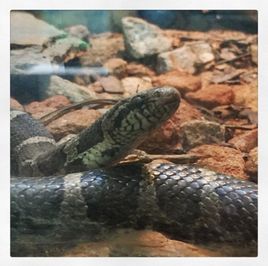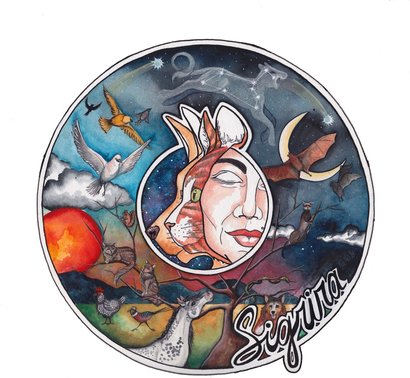 Every so often I like to write about animals that are less popular, in the hopes of shifting some perspectives. For my brand new logo (seen at the top of the page) I asked the wonderful artist who designed & painted it for me, Hilary K., www.hilarykart.com/ to include some “less universally loved” animals such as snakes and bats. Snakes are often feared, even those that are not venomous, even the sweet looking small ones that live in our gardens and hide from us rather than risk confrontation. In fact snakes have much more to fear from us, many people kill snakes on sight without thought as to whether they are a non-poisonous integral part of our ecosystem, without thought that this snake may be a mother, without any thought of this snake as an individual, a being. Snakes share a lot of knowledge about healing, and are even visually represented on the Rod of Asclepius which is an ancient Greek symbol associated with medicine, consisting of a serpent coiled around a rod. Snakes shed their own skins, which makes them wonderful examples of transformation and releasing that which no longer serves us in our lives, like old limiting beliefs. Snakes are here to help us, to show us what is possible. They have no arms or legs but they can move with amazing speed. They move with an “S” curve type motion, always graceful. They taste the temperature. They harbor no hate for us, although they do get tired of being misunderstood, feared and killed so often.
If you are one (of the many) who fears snakes, don’t feel bad, but please consider exploring that fear. When we confront our shadows we can shine light on them. Bright light can make an Anaconda look like a baby garden snake. Consider how a shadow can make someone appear like a giant at a certain angle. That is how fear warps & distorts our emotions. The fear could have been passed down ancestrally, either consciously or subconsciously. Try sending love to a snake somewhere. It could be sent to a photo of a snake, like this one posted, which I photographed at the Atlanta zoo. You could visit one that is (humanely) captive, like in a rescue sanctuary or an animal companion who spends some of their time in an enclosure, so the barrier helps you feel safe. These are ambassadors. You can ask them to show you where they would be in the wild if they were free. When you feel love there is no room for hate or fear. Think about what is lovely about the snake? The shiny scales? The colors? Some look like they are smiling. Please take an imaginary leap with me. Imagine that this snake is a person on their way home from work. Maybe they accidentally drove into your lane and frightened you as you had to quickly move over, or perhaps they are that relaxed person walking slowly as you are on the way to your car, they are enjoying the sunshine, while you are rushing and you feel they are intentionally blocking your path? Think about why they are enjoying the sunshine, maybe they live in the moment, maybe they need vitamin D to feel healthier. Who are they going home to? Is their dog patiently awaiting them? (This exercise might make us feel more kindly toward people as we commute too) Snakes are not people, but they are individual beings, as we are. I believe sometimes a bit of imagining can help us relate a bit better and lose some of the fear. We can also think about why snakes were given such a negative image in myths? What do they represent to you? Ultimately there is the symbolic snake and the actual real snake that may be in your garden. Please give them a chance at life, they are as much a part of our natural environment as the birds and the squirrels and (depending on where you live) most are non venomous and want to get away from you even more than you want to avoid them! I understand that there are poisonous snakes and this can be a concern especially with small dogs or children. That does not have to mean a death sentence for the snake. I live in Atlanta GA and we have an organization called the Amphibian Foundation that will actually come and pick up copperheads (our poisonous snakes) and safely relocate them unharmed to a nature preserve. If you do find a copperhead here in Atlanta and don’t want them in your yard, you can call the Amphibian Foundation. www.amphibianfoundation.org/ Please check for similar resources in your home town/country. If there are no outdoor animal companions or small kids, you can consider simply letting them stay. They do serve an important role for the ecosystem and if they were all gone there would be drastic consequences. Depending on the size of your yard, you could consider having certain areas that are more suited for wildlife, separate from sitting areas. This may sound cliché but I still love the saying “live and let live.” Comments are closed.
|
Archives
January 2021
|
|
|
©2013-2025 Sigrira, LLC,

 RSS Feed
RSS Feed